Grabfunde |
Hort und Streufunde |
Mähren und
Niederösterreich |
The fact that the densest and oldest concentration of finds of the Roman metal vessels in the entire non-Roman area to the east of the Rhine and north of the Danube is found in the territory of central and northern Bohemia has been pointed out many times. In the local cremation burying grounds and in the sporadic skeletal graves from the 1st third of the 1st century AD we find not only luxurious bronze, sometimes silver tableware too, but also goods of utility character manufactured in the workshops in the surroundings of Capua, Italy, and partly also in north Italian workshops. The goods have apparently flown here through the traders from Noricum, at that time a clientage Roman kingdom; to these traders a considerable part of the trade with the beyond-Danubian barbarian territories has been apportioned even in the preceding late La Tène period. Although the German graves from Bohemia show also examples of Roman import pervading to the north of the Danube even in the pre-Augustan period, e.g. buckets with dolphin- or heart-shaped attachments (according to Eggers classification types Nos. 18-19), in the graves from this period of time principally the high-quality products from Italian workshops of the Augustan period are prevalent. These are represented e.g. by splendid bronze buckets with mask handle attachments (Eggers 24), collections of jugs and bowls with fixed handles (pateras), luxurious bowls with palmette attachments of movable handles and some other products continuing the Hellenistic traditions of Alexandria manufacturing centres. As parts of drinking collection of this time the most widely spread were the collections of strainers and ladles with scroll-shaped broadened handles (Eggers 159), but mostly dippers with handles terminated by curls for hanging equipped with stylized bird heads (Eggers 131). The time of manufacture of these vessels is roughly Augustan, but early Tiberian period at the latest, while many of them have obviously got into the graves with a certain delay. Contrary to the late La Tène import these products are labelled as products of the 2nd generation of bronze vessels within the frame of which they are classified as its first phase according to R. Petrovszky.
According to a consensual judgement of researchers the unusually strong, and essentially sudden flow of import of Roman bronze vessels into the environment of the Germanic tribes, then settled in the territory of Central Bohemia, was related to the blossoming of the so-called Marobuduus Empire. The striking concentration of these vessels on a relatively small area reflects not only an existence of a centre of power of Marcomanni in the Czech basin, but also an eminent Roman interest in the development within this area, and possibly also an endeavour to exert a certain influence on it.
At that time somewhat different circumstances prevailed in the slightly more eastern territory, in the stripe stretching to the north from the middle course of the Danube and in the direct neighbourhood of the later provinces of Noricum and Pannonia I. It is roughly the territory of the today south and central Moravia, the adjoining parts of Lower Austria and south-western Slovakia. These areas may be understood as a natural geomorphologic whole that opens towards the Danube. Its main axes pointing to the north are formed by the Morava and Váh Rivers alongside of which important connecting lines between the Danubian basin and the Baltic have lead from of old (the so-called Amber Route).
Staré Hradisko (oppidum) |
|
 |
Bratislava-Devín |
Sládkovicovo |
Sládkovicovo |
Kostolná |
Bratislava-Devín |
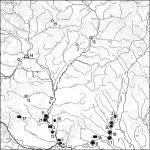 During the reign of Emperor
Tiberius, the successor of Augustus, there are marked changes of the situation
occurring in these regions as well. The increase in number of Roman metal vessels
may be related to founding of the first German burial grounds with the Elbe-Germanic ceramics mainly in the region along the downstream of March-Morava River and
in south-western Slovakia, the best known of which are cemeteries in Abrahám, Kostolná and Sládkovicovo. Although the oldest layer of bronze vessels
is represented by kinds known from the Czech region as well, their number is markedly lower here. The metal
vessels are again mainly represented by dippers with handle terminations in
the shape of bird heads (Eggers 131), early types of ladles and strainers with
scroll-shaped widened handles or transitory types (Eggers 159/160), bowls with
moving handles (Eggers 92) or bowls with fixed horizontal and striated handles
that are terminated by ram heads (Hagenow type pateras).
During the reign of Emperor
Tiberius, the successor of Augustus, there are marked changes of the situation
occurring in these regions as well. The increase in number of Roman metal vessels
may be related to founding of the first German burial grounds with the Elbe-Germanic ceramics mainly in the region along the downstream of March-Morava River and
in south-western Slovakia, the best known of which are cemeteries in Abrahám, Kostolná and Sládkovicovo. Although the oldest layer of bronze vessels
is represented by kinds known from the Czech region as well, their number is markedly lower here. The metal
vessels are again mainly represented by dippers with handle terminations in
the shape of bird heads (Eggers 131), early types of ladles and strainers with
scroll-shaped widened handles or transitory types (Eggers 159/160), bowls with
moving handles (Eggers 92) or bowls with fixed horizontal and striated handles
that are terminated by ram heads (Hagenow type pateras).
Kostolná |
Kostolná |
Drösing |
Mannersdorf a. d. March |
|||
 |
 |
Trebusice |
Trebusice |
 |
 |
|
| Mistelbach | Kostolná | Kostolná |
Láb |
|||
Križovany nad Dudváhom |
|
Križovany nad Dudváhom |
||||
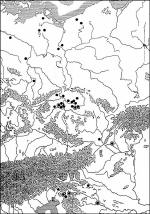
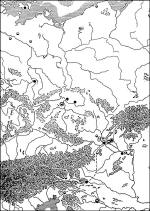 A prevalence of these
finds in the area to the north of Carnuntum where new purchase centres emerge
as a result of political changes and continuing migrations is best illustrated
by a comparison of their occurrence in both regions. Thus for example the numerary
prevalence of Augustan dippers with handle terminations in the form of bird
heads (Eggers 131, or 135) over dipper variants with lunate or semicircular
opening (Eggers 137-140) is documented by the 6 : 1 ratio in Bohemia, whereas
in the North Danubian stripe this ratio is almost inverse, and makes 1 : 4
in favour of the younger late Augustan and Tiberian types.
A prevalence of these
finds in the area to the north of Carnuntum where new purchase centres emerge
as a result of political changes and continuing migrations is best illustrated
by a comparison of their occurrence in both regions. Thus for example the numerary
prevalence of Augustan dippers with handle terminations in the form of bird
heads (Eggers 131, or 135) over dipper variants with lunate or semicircular
opening (Eggers 137-140) is documented by the 6 : 1 ratio in Bohemia, whereas
in the North Danubian stripe this ratio is almost inverse, and makes 1 : 4
in favour of the younger late Augustan and Tiberian types.
Kostolná |
| SládkovicovoSládkovicovo |
| Apart from attachments and a handle which have been secondarily fastened to a markedly younger vessel from the princely grave in Mušov, out of this kind of situlae originate also the handles from the collection of finds, perhaps an inventory of an early grave, in Schwechat near Vienna. Their analogues from a Danish princely grave near Hoby and a Rhine-basin whole in Mehrum justify a conclusion that the buckets have also been manufactured prior to the half of the 1st century although their placing into the grave has been reckoned with as late as around the half of the 1st century. | |||
Mušov |
|||
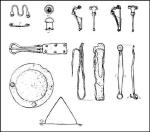 |
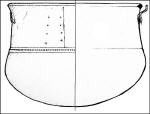 |
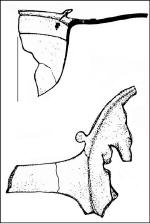 |
Mannersdorf a. d. March |
||
On the whole increase of the bronze vessel import into the region north of the middle Danube in the Tiberian period presents a mixture of forms that fall within both the first, but mainly the second phase of the so-called second generation of bronze vessels according to R. Petrovszky. Rather than to the Czech grave compounds from the local top phase it is thus closer to the inventory of the older stratum of the so-called princely graves of Eggers B1 stage, scattered in the other regions of the non-Roman Germania, and best represented by the collections from the older cremation grave from Hagenow, from skeleton graves in Hoby, from graves I/1908 and III/1913 in Lubieszewo (Lübsow), from grave II in Rzadz in Poland, or the cremation grave 150 in Putensen in the region along the downstream of Elbe. From the chronological point of view analogous examples of import in the region to the north of Carnuntum may be justifiably related with the existence of the so-called Vannius kingdom the decline of which in the year 50 AD has created the prerequisites for a further development of the Roman import of metal vessels into the region in the period to follow.
The latest researches provide for an opinion that the import of Roman metal vessels escalates only after the overthrow of the Quadian king Vannius, i.e. roughly from the Claudian period. It brings products we would, according to R. Petrovszky´s classification, label as early products of the 3rd phase of the 2nd generation bronze vessels. The finds from this import phase greatly outnumber the sum of vessels that have reached the territory to the north of the Danube in the 1st half of the 1st century. According to the latest knowledge the time of their production falls within the period of time roughly from the thirties, or forties of the 1st century to the late stage of this century.
Blucina |
|||
Drásov |
||
Blucina |
|||
The then imported range is again dominated by dippers. In addition to the previously known types with a lunate or a semicircular hole in the terminating discoid of the handle, albeit of a more advanced character, there are highly predominant forms with a circular cut-out of the terminating disc. Peculiar for all types of dippers of this group are more massive ends with bottoms bearing relief concentric furrows; these illustrate that the Italian workshops have adopted more effective manufacturing processes during which the products have been additionally turned. The dippers of the above type are abundantly encountered both in the burial grounds of the Abrahám-Kostolná-Sládkovicovo circuit and in the graves of the Lower Austrian – South Moravian region, e.g. in Drásov, Breclav, Mistelbach etc.
Staré Mesto |
|
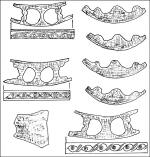 |
Mistelbach |
 |
|||||
Gefäße der 3. Phase der 2. Bronzegefäßgeneration
na Petrovszky |
|||||
Mušov |
|||
Velatice |
||||
As early as in this period the products of Gallic workshops start to appear; these have been increasingly taking over the role of the Italian manufacturing circles and edging out the obviously more expensive products of Campania out of the market. These include e.g. a dipper with a simplified Gallic thyrsus on a handle that was terminated by a disc with a circular cut-out, from grave 6 in Velatice. The numbers of examples of simpler collections of ladles and strainers with rod- or row-shaped handles that flow into Germanic markets as a new kind of bronze utensils are on the increase. Since the Claudian-Flavian period various variants of simple, barrel-shaped buckets have been flowing into the areas to the north of the Danube; these buckets are often found in Germanic graves, and therefore they can hardly be considered really valuable gifts but rather articles of a common barter trade.
Favourable conditions for the increase of import of bronze vessels into the beyond the Danubian frontier of the barbaricum were also given by the efforts of Rome to enter into stronger trade relations with the Baltic regions where amber was exploited; these relations were especially on the increase during Emperor Nero. Another factor might have been the internal political situation in Rome itself after the death of this emperor. As follows from the reports by Tacitus, Vannius´ followers have remained allied to the Imperium. It is known that Italicus and Sido, the Suebian kings, have fought on the side of Emperor Vespasian during the civil war, and together with their warriors they have participated in the battle of Cremona. In this context there are deliberations about a certain possible relation of these events and an abundant occurrence of green-glazed, Upper Italian ceramic kantharoi in the Germanic graves of south-western Slovakia, that are even sometimes interpreted as spoils of war. Besides, to this effect it would be possible to explain also the origin of some antique pieces of Augustan silver vessels and luxurious ancient toreutics dated back to Augustan or an even older period (a bronze lamp, a folding table), that were found in the royal grave of Mušov. It is primarily their exclusivity and an absence of persuasive parallels in the entire Middle Danubian area that intercedes for such interpretation.
 |
 |
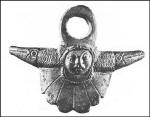 |
Vysoká pri Morave |
||
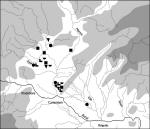
 |
Zohor |
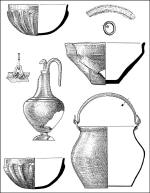 |
Neuruppersdorf |
Rothenseehof |
||
Zohor |
Zohor
|
||
 |
Vysoká pri Morave |
|
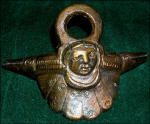 |
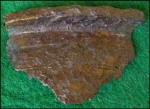 |
 |
Menín |
||
Although the examples of this import horizon are not absent even in the region between the Váh and the Lesser Carpathian Mountains (Abrahám, Kostolná, Sládkovicovo), an agglomeration of luxurious finds especially in the area on the Slovak bank of the River March-Morava and in the borderland of Moravia and Lower Austria is certainly striking. The Germanic archaeological evidence, which moreover betrays certain relations to the north Elbe environment, does not exclude that further movement of the Elbe region tribes towards the Danube that have culminated by Domitian wars at the very end of the 1st century and the final consequence of which has been the stabilization of the new centre of power to the north of central Danube could have been in the background of the strengthening of trade and cultural contacts between the more distant north Elbe area and the Roman Danube basin. According to the latest knowledge these can be attributed to the Danubian Marcomanni.
 |
Zohor |
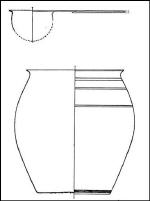 |
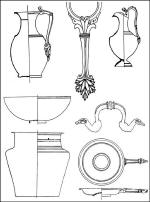 |
Zohor |
|
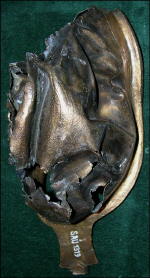 |
 |
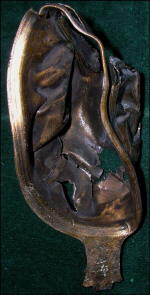 |
Zohor |
||
Zohor |
|||
This fact is even more remarkable as the common bronze vessels imported into the north Danubian area after year 100 as tippers, strainers and ladles, cask - buckets etc. have survived here in the numerous Germanic collections at least until the Marcomannic wars.
Velatice |
||
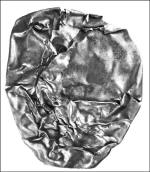 |
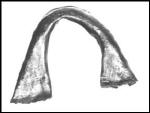 |
Mikulov |
|
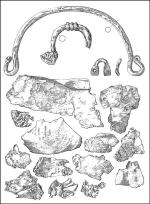 |
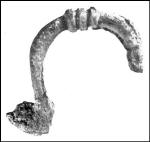 |
Mikulov |
|
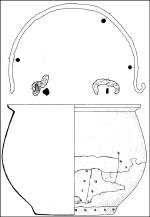 |
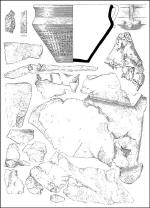 |
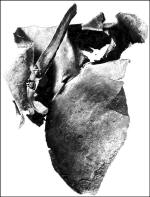 |
|
Blucina |
Mikulov |
||
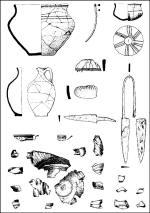 |
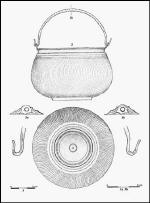 |
Šitborice |
Czarnówko |
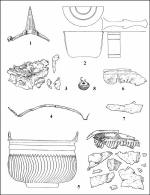 |
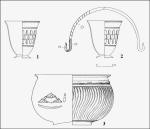 |
Baumgarten |
Dvory nad Žitavou |
Bucovice |
||||
Mušov |
Šitborice |
Šitborice |
||
Šitborice |
|||
Mušov |
Zohor |
Mušov |
||
Mikulov |
The early variants of big cauldrons of the so-called Westland type, especially the exemplar from the royal grave of Mušov equipped with four additionally mounted busts of barbarians with a characteristic hair style, the so-called Suebian bun, may be considered unique in the area to the north of the middle Danube. The evidence of the late dating of these products originating from the provincial workshops, probably after year 150, is, apart from other things, a practically identical, but regrettably only fragmentary cauldron from the cremation grave 6 in Mikulov, dated by a germanic type of a belt endings to the late B2 stage B2 or rather stage B2/C1 (180-200).
Distribution map of
riffled buckets; other
bronze vessels |
Basically it is possible to agree with the opinions of the authors who relate this unprecedented flow of Roman conveniences into the barbarian sphere to the situation that has occurred after the Marcomannic wars. Especially in the barbarian regions adjacent to the Roman border on the middle Danube a lively trading and barter contact with the provinces has developed until the Severian period. The causes of the unprecedented advancement have not only consisted in the internal changes of the barbarian society but also in the designed policy of Rome in the period after Commodus peace. This policy was characterized by a support of the pro-Roman groups within the barbarian society, but above all an effort to secure a safe Roman border by means of bribery, subsidies and other benefits to the Germanic chiefs, and obviously also a wide opening of trade contacts as it is evidenced by a mass tide of samian ware of the late Antonine and Severian dating. Much as it is possible to explain the spreading of bronze vessels, Roman utensils and other luxurious products to the distant corners of Przeworsk culture and the regions on the shores of the Baltic sea as a result of an intra-Germanic barter occurring among the individual barbarian centres and the consequent redistribution, the distribution of the Roman pottery has obviously still remained in the hands of the Roman traders.
A fundamental change has been the phase starting with the thirties of the 3rd century when the Roman Empire from the Upper Germanic – Raetian frontier to the provinces in the east of Europe has been shaken by violent attacks of the barbarians caused by migration waves springing from within the non-Roman Germania. These have mainly resulted in an interrupted import of products from the more westerly provinces into the central Danubian sphere and further to the barbarian take-off regions to the north of the Danube. The last reverberations of the western import of luxurious bronze vessels are the Hemmoor buckets from the graves of Krakovany-Stráže, which, together with a terra sigillata bowl by the late Rheinzabern master Regulinus, fall outside of the chronologic scope of the theme.